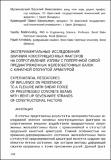| dc.contributor.author | Малиновский, Василий Николаевич | |
| dc.contributor.author | Кривицкий, Павел Васильевич | |
| dc.coverage.spatial | Минск | ru_RU |
| dc.date.accessioned | 2022-02-25T09:07:28Z | |
| dc.date.available | 2022-02-25T09:07:28Z | |
| dc.date.issued | 2016 | |
| dc.identifier.citation | Малиновский, В. Н. Экспериментальные исследования влияния конструкционных факторов на сопротивление изгибу с поперечной силой преднапряженных железобетонных балок с канатной отогнутой арматурой = Experimental researches of influence on resistance to a flexure with shear force of prestressed concrete beams with bent-up seven-wire strands of constructional factors / В. Н. Малиновский, П. В. Кривицкий. – Текст : непосредственный // Проблемы современного бетона и железобетона : сборник научных трудов / Министерство архитектуры и строительства Республики Беларусь, Институт БелНИИС ; редколлегия: О. Н. Лешкевич, Н. П. Блещик, П. В. Алявдин [и др.]. – Минск : Колорград, 2016. – Выпуск 8. – С. 134–154. – Библиография: 5 назв. | ru_RU |
| dc.identifier.uri | https://rep.bstu.by/handle/data/26761 | |
| dc.description | Malinovsky V. N., Krivitsky P. V. Experimental studies of the influence of structural factors on the resistance to bending with a transverse force of prestressed reinforced concrete beams with bent rope reinforcement | ru_RU |
| dc.description | The results of experimental researches of influence of major constructional factors on resistance of prestressed reinforced concrete beams with rectilinear and bent-up longitudinal seven-wire strands by external action are presented in article. The main feature of the mode of deformation of prestressed reinforced concrete beams with bentup reinforcement is to create condition at a pressing concrete stage, at which compression deformations vectors are inclined to a point of the application of prestress force. The given fact influences on orientation and sizes of main deformations from external loading. By this reason at a previous inclined cracks stage the main tensile strains of concrete in the middle of height of sections in beams with the bent-up reinforcement are less than limiting. Main tensile strains sizes approach limiting faster in average part of section height in beams with rectilinear reinforcement that predetermines further formations of the inclined cracks beginning in this part of section. Changing of prestress force degree influences on location and angle of critical cracks, changing of bent-up seven-wire strands angle influences on normal and bending shear cracking load at nearsupport zone. The length of a zone of transfer prestressing increases by using seven-wire strands of smaller diameter and, as consequence, prestress force concrete decreases, that in the subsequent affects size of cracking loading and beams destruction, as well as concrete strength changing influences on propagation of inclined cracking and failure load. | |
| dc.description.abstract | В статье представлены результаты экспериментальных исследований влияния основных конструкционных факторов на сопротивление внешним воздействиям предварительно напряженных железобетонных балок с прямолинейной и отогнутой продольной канатной арматурой. Главной особенностью напряженно-деформированного состояния железобетонных балок с отогнутой преднапряженной арматурой является создание при обжатии бетона состояния, при котором векторы деформаций сжатия направлены к точке приложения усилий. Данный факт оказывает влияние на ориентацию и величины главных деформаций при загружении внешней нагрузкой. По этой причине на стадии, предшествующей образованию наклонных трещин, в середине высоты сечений в балках с отогнутой арматурой главные растягивающие деформации бетона значительно меньше предельных. В балках с прямолинейной арматурой величины главных деформаций растяжения приближаются быстрее к предельным в средней части высоты сечения, что предопределяет в дальнейшем образование наклонных трещин в данной части сечения. Изменение
степени обжатия бетона влияет на расположение и угол наклона
магистральных наклонных трещин, изменение угла наклона отогнутого каната - на нагрузку образования в зоне среза нормальных и наклонных трещин с растянутой зоны сечения конструкции.
При использовании канатов меньшего диаметра увеличивается
длина зоны передачи преднапряжения и, как следствие, уменьшается уровень обжатия бетона в сечениях, что в последующем сказывается на величине нагрузки образования трещин и разрушения балок, а изменение прочности бетона влияет на последовательность образования и морфологию развития наклонных трещин и величину разрушающей нагрузки. | ru_RU |
| dc.language.iso | ru | ru_RU |
| dc.publisher | Колорград | ru_RU |
| dc.subject | ferroconcrete | ru_RU |
| dc.subject | железобетон | ru_RU |
| dc.subject | балки | ru_RU |
| dc.subject | beams | ru_RU |
| dc.title | Экспериментальные исследования влияния конструкционных факторов на сопротивление изгибу с поперечной силой преднапряженных железобетонных балок с канатной отогнутой арматурой | ru_RU |
| dc.type | Статья (Article) | ru_RU |
| dc.abstract.alternative | The results of experimental researches of influence of major constructional factors on resistance of prestressed reinforced concrete beams with rectilinear and bent-up longitudinal seven-wire strands by external action are presented in article. The main feature of the mode of deformation of prestressed reinforced concrete beams with bentup reinforcement is to create condition at a pressing concrete stage, at which compression deformations vectors are inclined to a point of the application of prestress force. The given fact influences on orientation and sizes of main deformations from external loading. By this reason at a previous inclined cracks stage the main tensile strains of concrete in the middle of height of sections in beams with the bent-up reinforcement are less than limiting. Main tensile strains sizes approach limiting faster in average part of section height in beams with rectilinear reinforcement that predetermines further formations of the inclined cracks beginning in this part of section. Changing of prestress force degree influences on location and angle of critical cracks, changing of bent-up seven-wire strands angle influences on normal and bending shear cracking load at nearsupport zone. The length of a zone of transfer prestressing increases by using seven-wire strands of smaller diameter and, as consequence, prestress force concrete decreases, that in the subsequent affects size of cracking loading and beams destruction, as well as concrete strength changing influences on propagation of inclined cracking and failure load. | |
| dc.identifier.doi | https://doi.org/10.23746/2016-8-8 | |
